The photographs of George Byrne revel in a stillness that is part mystical, part abstract, and entirely surreal echoing the dichotomous nature of the city of Los Angeles that the artist has adopted as home. Curated by Margot Ross, Post Truth is both a solo exhibition and book release exploring five years of work that has been thoughtfully distilled. Byrne’s work explores painterly and photographic processes but more than anything else it’s the work of an archivist preserving humble corners and unlikely spaces of Los Angeles and memorializing them on film before they are forgotten forever.
Post Truth presents a study of Los Angeles with photographic documentation that spans the period from 2015-2020. The version or the “truth” of the city presented in the titular book of 56 images and exhibition of 18 large-scale photographs documents scenes of Los Angeles devoid of automobiles. While a few images include a lone pedestrian, their absence speaks to the car-centric landscape where native Angelenos seldom walk. The subjects of Post Truth are slices of architecture with a precarious existence as Los Angeles famously ignores history and is quick to demolish and rebuild. You bring attention to previously unnoticed street corners where primary paint colors converge and angles of neighborhoods are anchored in a newfound geometric harmony. The sentiment that speaks loudest is the stillness embedded within each photograph. Viewing the only city that I have called home through the lens of “Post Truth,” feels like seeing Los Angeles for the very first time. What most captivates your imagination about this city?
It’s always particularly interesting for me to get feedback from people like you who have been immersed in this landscape since you were born. A lot of the things that I’m seeing are invisible to you [because you’re from Los Angeles]. A big part of my work and the seed of my work is a reaction to an alien landscape. Every time I travel I have that reaction but not like this. My reaction to this landscape- LA- was a deep calling. There was [a feeling that told me] “you have no choice but to do this. You’ve seen something that’s bizarre. Start looking at it and try to decode it and try to find the thing that is calling you out.” So the beginning of it all was curiosity. As a foreigner, I’m not too sure how I’m affecting locals in terms of the perception of their own city but most of the feedback I get is positive. LA is not famous for its beauty like New York and San Francisco and Chicago and these other architectural cities – LA has never had that. It’s always sort of been an aesthetic underdog and the butt of the joke almost in an aesthetic way. I’ve always kind of found myself drawn to that storyline of the underdog. I think there was something in me that was also like taking a bit of pride in the city that I had chosen as my new home.

archival pigment print
47.5 x 58.75 in.
Edition of 5 + 2AP
Installation image courtesy of Danny Duarte
Artwork image courtesy of George Byrne

archival pigment print
47.5 x 58.75 in.
Edition of 5 + 2AP
Installation image courtesy of Danny Duarte
Artwork courtesy of George Byrne
Artists with deep roots in Los Angeles including David Hockney, Ed Ruscha, and fellow members of the “Cool School” were beacons of inspiration as you looked at the city from afar in your native Syndey, Australia and whilst studying at Sydney College Of The Arts. How did the photographic and painterly artifacts of the city in their work influence your photographs?
And this other guy called Lewis Baltz, a photographer who I remember looking at his book when I was in college. Now I realize he’s totally looking at the same thing now through a different camera and a different perspective, but the same essence. Finding a seed of something quite beautiful but strange in the most unlikely, barren, urban places. I’m kind of in limbo somewhere between a more painterly idea and a photograph. So that was also a very gradual transition that I was making and I still don’t know exactly where I fit, it depends on how you look at it. I feel that I’m sourcing from both worlds a bit and hopefully presenting a unique perspective.
In the foreword of Post Truth, you suggest that your photographs have a malleable quality, delicately balancing between paintings and photographic compositions. The Mamiya 6 and Pentax 67 medium format cameras that you employ act like a brush and a chisel, carving out the essence of the subject. The very nature of medium format film demands intentionality behind each shot. How has your approach evolved?
I have felt like as I’ve been doing this and evolving sometimes I’m consciously honoring the true structural integrity of what I’m truly seeing. Other times it’s like I’m going to approach this- there’s a scene I’ll find that has something going on that’s kind of interesting and I’ll come at like a sort of golfer lining up a putt, you know? I’ll go around, get some different angles, and even squat down like a golfer sometimes. Hate golf, by the way, I can’t stand it. I just want to put that on the record. (Laughs)
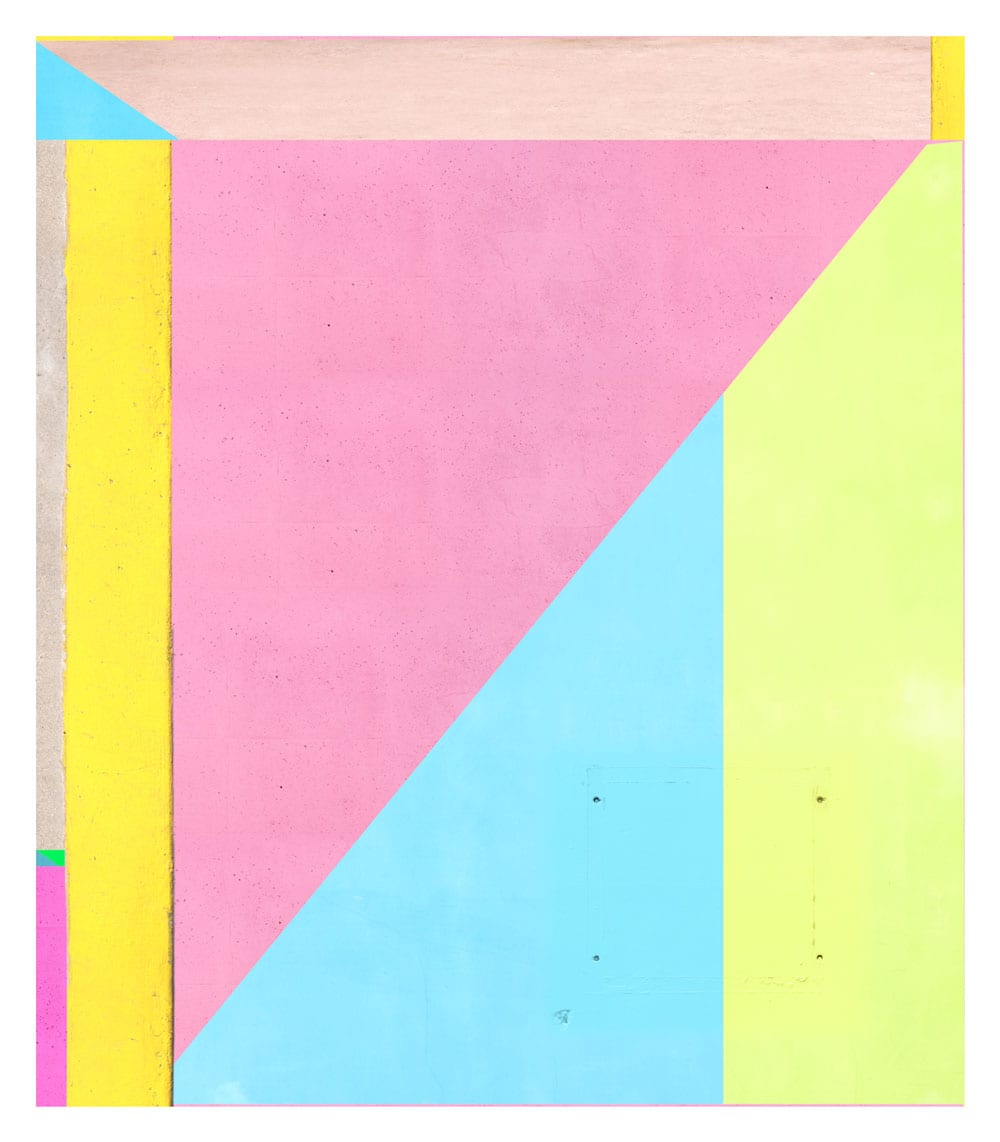
archival pigment print
47.5 x 54.5 in.
Edition of 5 + 2AP
Installation image courtesy of Danny Duarte
Artwork courtesy of George Byrne
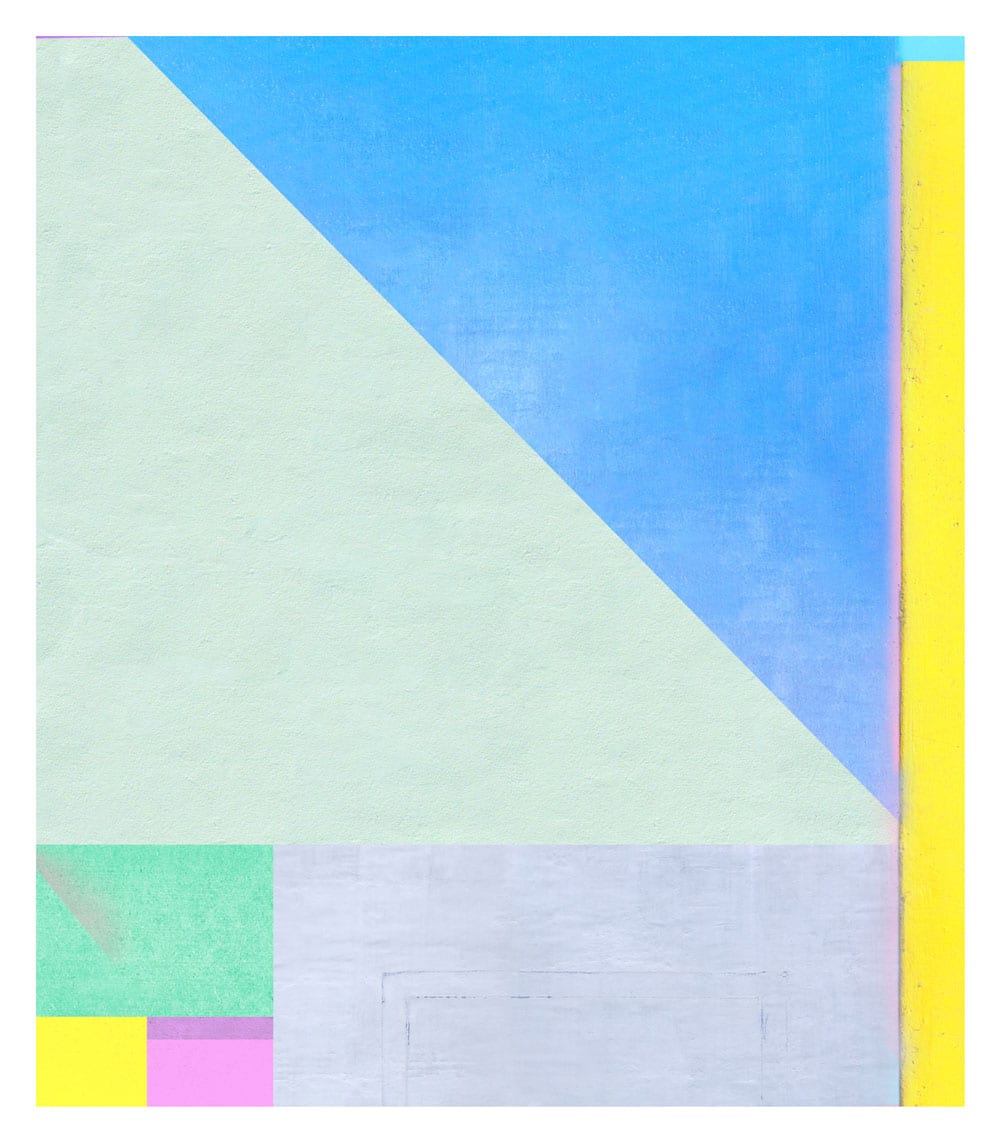
archival pigment print
47.5 x 54.5 in.
Edition of 5 + 2AP
Installation image courtesy of Danny Duarte
Artwork courtesy of George Byrne
There are two photographs Wall Detail #1 and Wall Detail #2 that stand apart from the others in the gallery. They accentuate the Art Deco palette discovered in other images but these focus on a hyper-real surface. The two images celebrate a dynamic facade exploring weight and texture.
You bring up the wall detailing and they are two of the more recent ones and they were a massive departure from everything else in the room. In one sense, they were never seen in-camera. Ever. They were conceived on a piece of paper with a pencil and a ruler and that was the beginning of those images. So I created compositions- I knew my work was leaning toward painting and I was like “ok, so what if I really went all the way and stepped right in it and tried to build something from nothing? With photographic material but a painterly-like approach to composition with painting and drawing.” So that was an example of me really mashing them together and see how they worked on the scale and that was very kind of experimental to me.
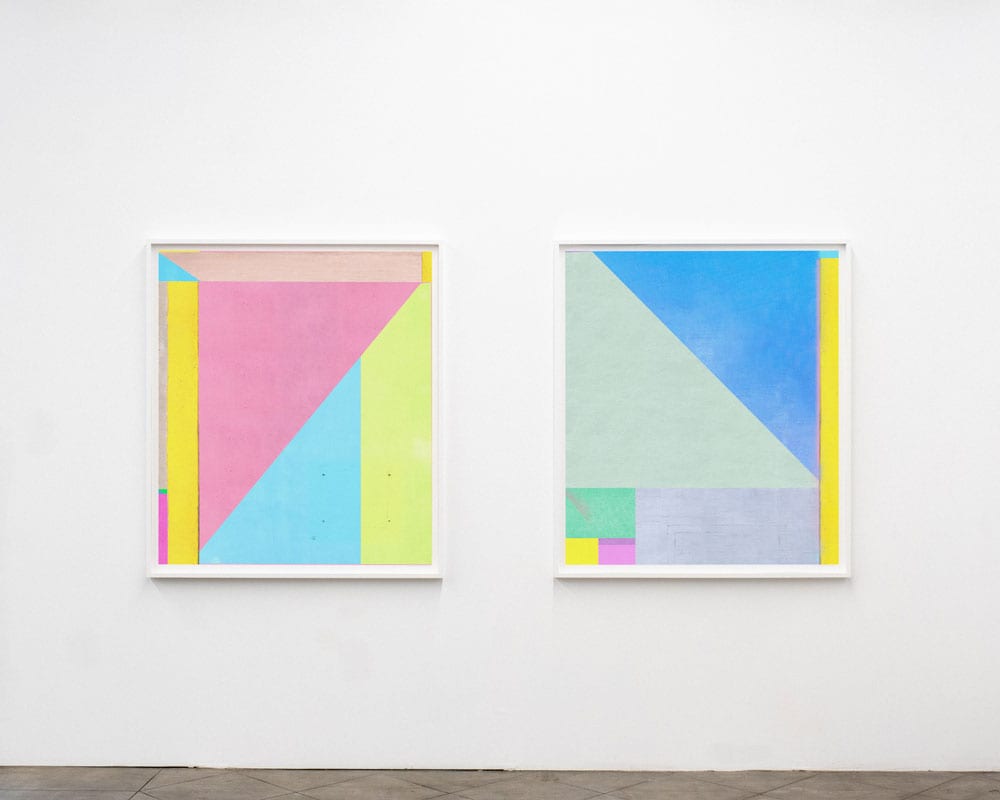
Installation image courtesy of Danny Duarte
Artwork courtesy of George Byrne
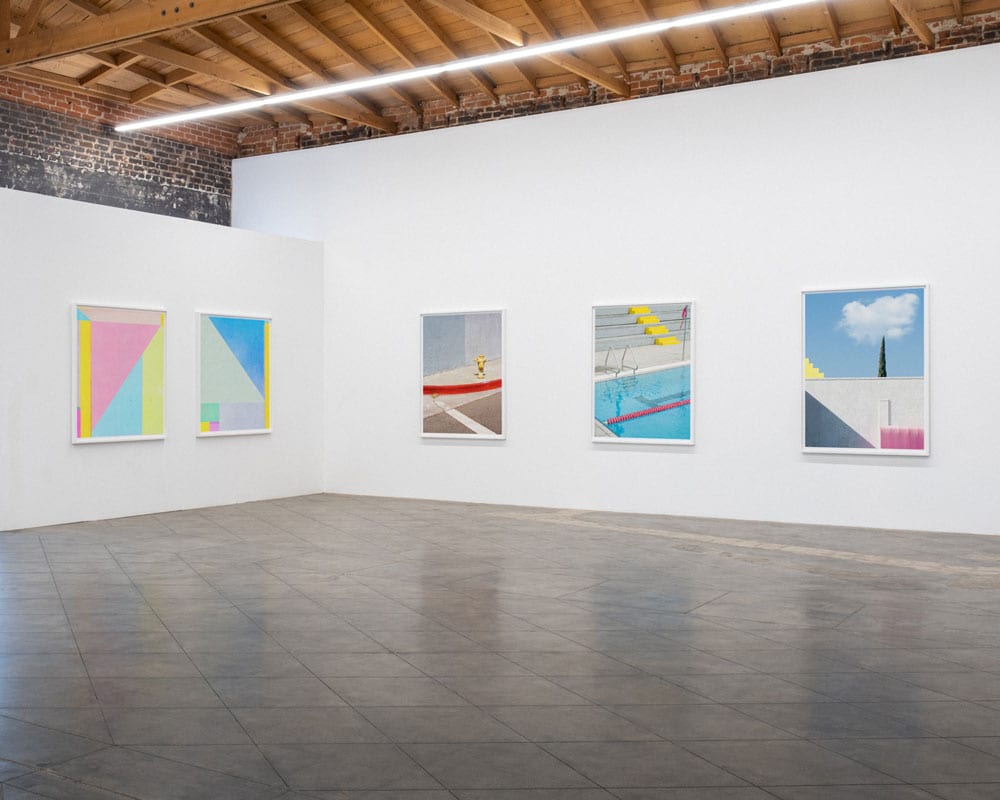
Installation image courtesy of Danny Duarte
Artwork courtesy of George Byrne
What was the process of determining which images captured over the last five years would appear in the show and the book?
It’s a bit varied. I don’t feel any necessary obligation to represent anything in any certain way at this point. I’m just looking for the image and I’m looking for an interesting interaction between surface, color, shadow, light, composition. I’m trying to find that perfect mix and it’s a lot of trial and error. I look at a thousand things and I’ll try to take a photo of five from the thousand. And of those five I’ll use one in a hundred. It’s a labor-intensive process and part of the joy of this exhibition was that I was able to cherry-pick a small group of what I perceived to be the more successful photos from the book and from my career. I could choose the ones that I thought worked the best and were the most interesting and curate them with Margot in a way that made sense and that doesn’t happen very often and that’s never happened to me. I can have a greatest hits show of my own. I didn’t know if that would even work but I was a musician in a past life and putting on exhibitions I’ve always felt like a cross parallel to the process. When you make a record as a musician you’re making ten or twelve songs. You’ve always got a single. There are these things that good records have. Flow and balance. Songs that are hidden tracks that grow on you after time. And it’s always felt the same way about groups of images that I’m working on for exhibitions and trying to find the perfect flow. I think these images are my small homage to the city and I feel like I can almost scratch the surface at this point. There’s a sort of dance that you do between managing what you’ve already created and are creating new stuff. You have to find that balance. I’m in a stage right now where the book was very much a pull of the handbrake. I consciously decided to do it because I knew that the only way to stop making work is if I made a book and would allow me to capture this chunk of time- succinctly, write about, put everything in place and there are five years. I can’t wait to do it for the next one but I needed the book to be able to clarify that in my head.
The landscape of Los Angeles reads very much like a palimpsest whereby we can discover changes made to space over time- new paint and an updated logo on an older building, splintering pavement and potholes, and renovations that attempt to match the original architecture. In many ways, your photographs are a way of carbon dating a city.
That’s a great way of putting it! Like an eroded side of a mountain, you can see different layers of sediment and minerals and there’s a dinosaur bone sticking out. Yeah, that’s it! There’s a John Fante quote that I put in the book about the desert beneath the streets and you feel it here. [The quotation from the 1939 novel Ask the Dust reads] “Here was the endlessly mute placidity of nature, indifferent to the great city; here was the desert beneath these streets, around these streets, waiting for the city to die, to cover it with timeless sand once more.” You do feel like if you put a shovel in here and dig there’s going to be sand. And as I’ve gone over time I’ve ended up being a cultural preservationist. A lot of the places I shoot change. They’re not famous buildings, they’re just humble corners of this or that and they get knocked down or painted black or things shift and move. Even the work from the show, half of those places aren’t the same anymore so that’s been an interesting byproduct of doing the work as well.

archival pigment print
58.5 x 47.75 in.
Edition of 5 + 2AP
Installation image courtesy of Danny Duarte
Artwork courtesy of George Byrne
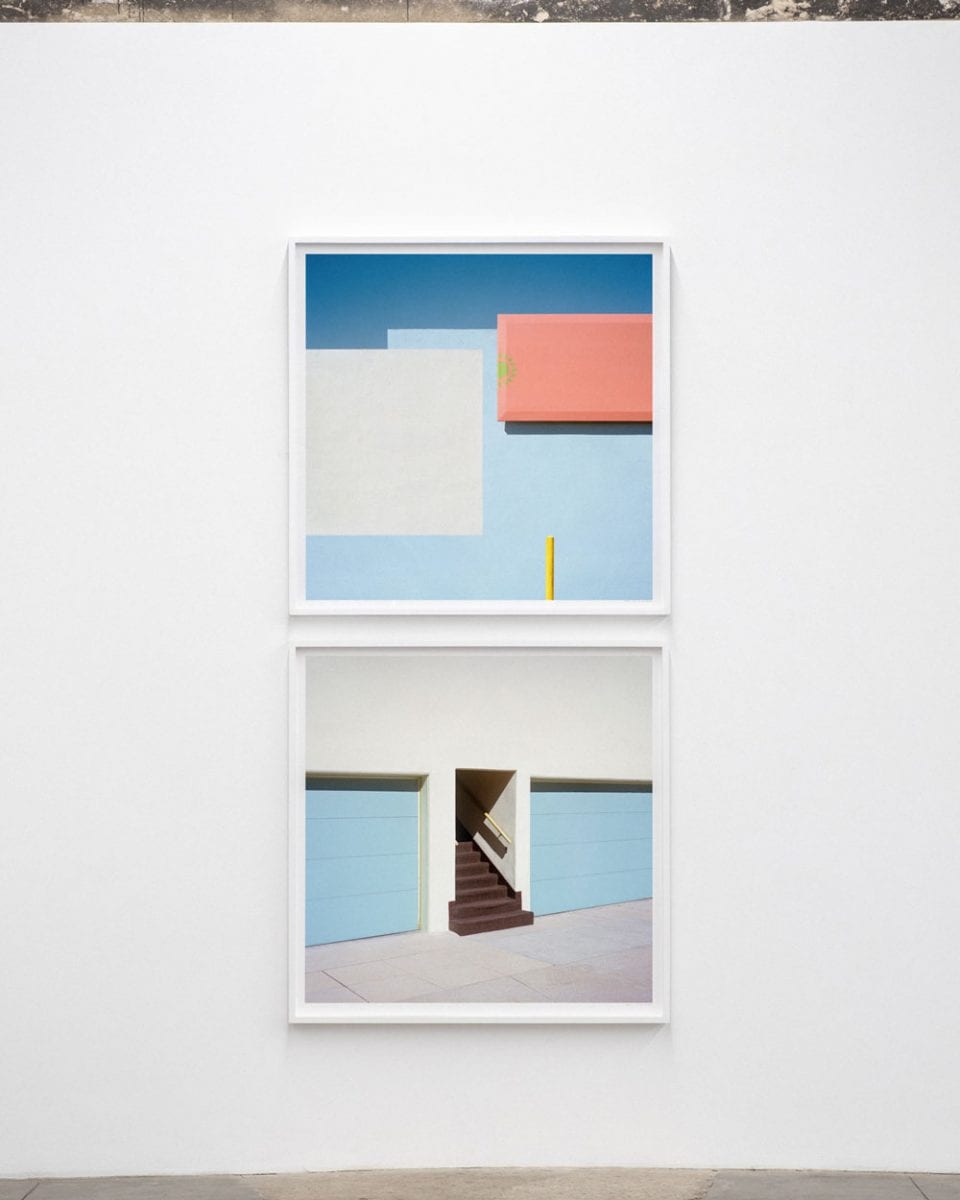
archival pigment print
41.5 x 41.75 in.
Edition of 5 +2AP
(Bottom) George Byrne, “Burbank,” 2017
archival pigment print
41.5 x 41.75 in.
Edition of 5 + 2AP
Installation image courtesy of Danny Duarte
Artwork courtesy of George Byrne
The inclusion of John Fante felt organic to the story of Los Angeles that you are reporting and conserving. His alter ego and protagonist Arturo Bandini is determined to make a name for himself as a writer in his newly adopted city. Your inclusion from Ask the Dust prompted me to revisit Mike Davis’s City of Quartz: Excavating the Future in Los Angeles, a body of work that continues to further dig the sand beneath the streets. Davis includes words from The American City: Literary and Cultural Perspectives edited by Graham Clarke which echoes your desire to explore surface, color, shadow, light, and composition. The excerpt reads, “Los Angeles seems endlessly held between these extremes of light and dark- of surface and depth. Of the promise, in brief, of a meaning always hovering on the edge of significance.”
Something intangible in the air. Yeah, maybe that’s too with the collective spirit- the oddball selection of people that live here which I love and am proudly one of. But it’s not a normal place in that sense, it really isn’t. There are very few cities I think that are made up of people the way this place is. I think there’s an essence that touches me deeply and I feel very at home here. It’s a very welcoming place for people like me, I think who maybe didn’t feel completely satisfied where they were born.

archival pigment print
47.5 x 58.75 in.
Edition of 5 + 2AP
Installation image courtesy of Danny Duarte
Artwork courtesy of George Byrne
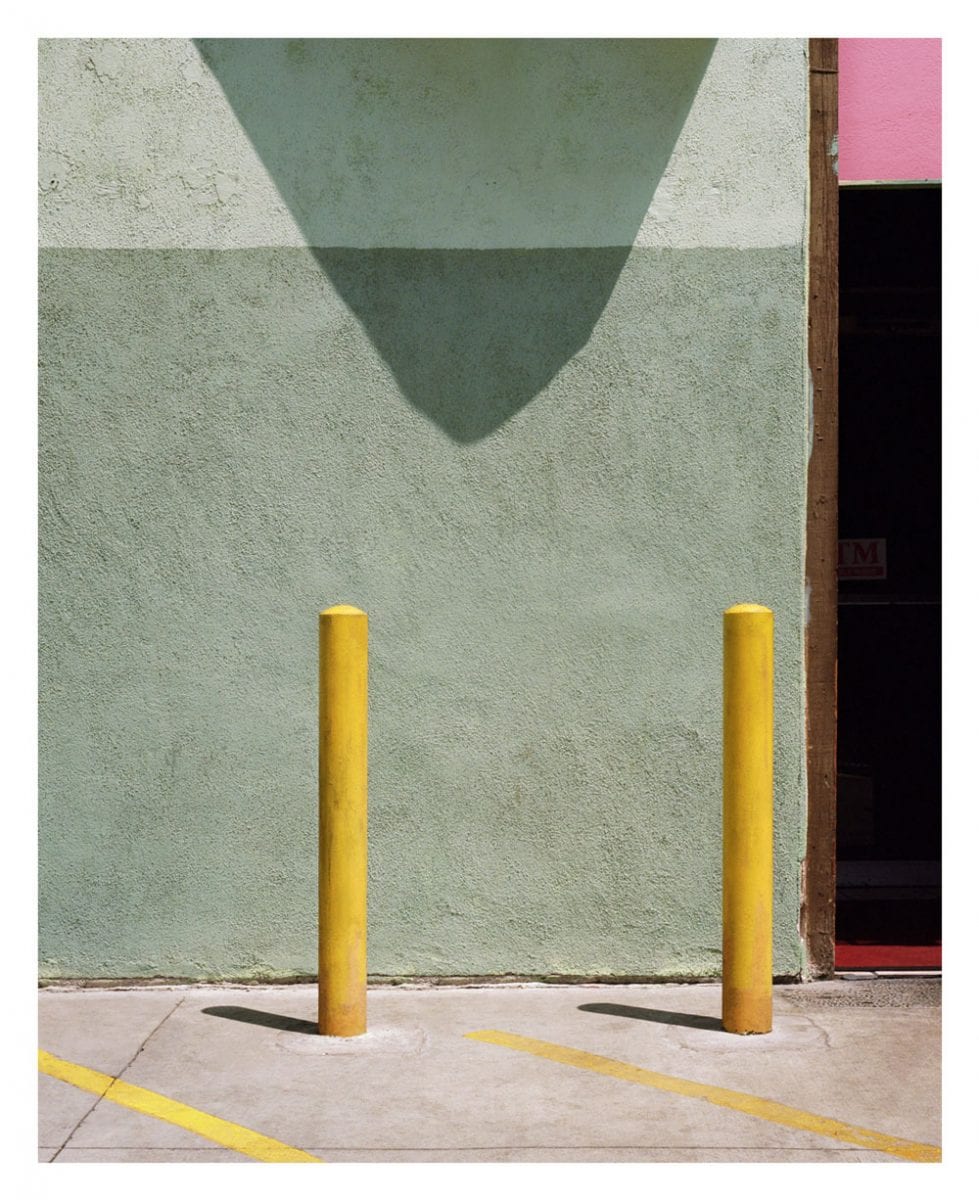
archival pigment print
47.5 x 58.75 in.
Edition of 5 + 2AP
Installation image courtesy of Danny Duarte
Artwork courtesy of George Byrne
You mentioned that you were a musician in a past life. Do you feel that there is a correlation between music and photography?
I think there are definite parallels. I was thinking the other day, I see a lot of my photos like a chord. I could almost connect the colors and get on a piano and find a chord for each image. It would be an interesting thing for me to try to do. I don’t think of it when I’m shooting or creating but when it’s up on the wall and finished I really do think of the images being a combination of elements to make a whole. That’s exactly what a chord is and is looking for. Each still image has exactly the same elements as to how they affect you and how they look.
The “combination of elements” that you speak about surfaces when the viewer is trying to negotiate the mystery of the Post Truth landscapes.
I’ll take the landscape in and then I’ll simplify it or switch it out but I’m trying to bring it to the bare basics, the essence of what I’m looking at. That’s another way I think I have adopted a different way of seeing. I think a lot of that is the luck of the moment- not luck but just a combination of I’m in this moment of history where this technology was happening and I moved here and I bring all these influences to the table that I’ve studied and all these things lined up. I knew when I started doing it that I was onto something, I had a feeling like just for me personally and as an artist- it’s rare that you feel that. A lot of the time you’re searching in the dark with a flashlight and copying your favorite musician or artist, you know?
And after searching long enough you discovered you had arrived at an authentic style.
It just felt like I was doing something unique. And touching on something that I hadn’t seen really done in the way that I was doing it and that was super exciting.
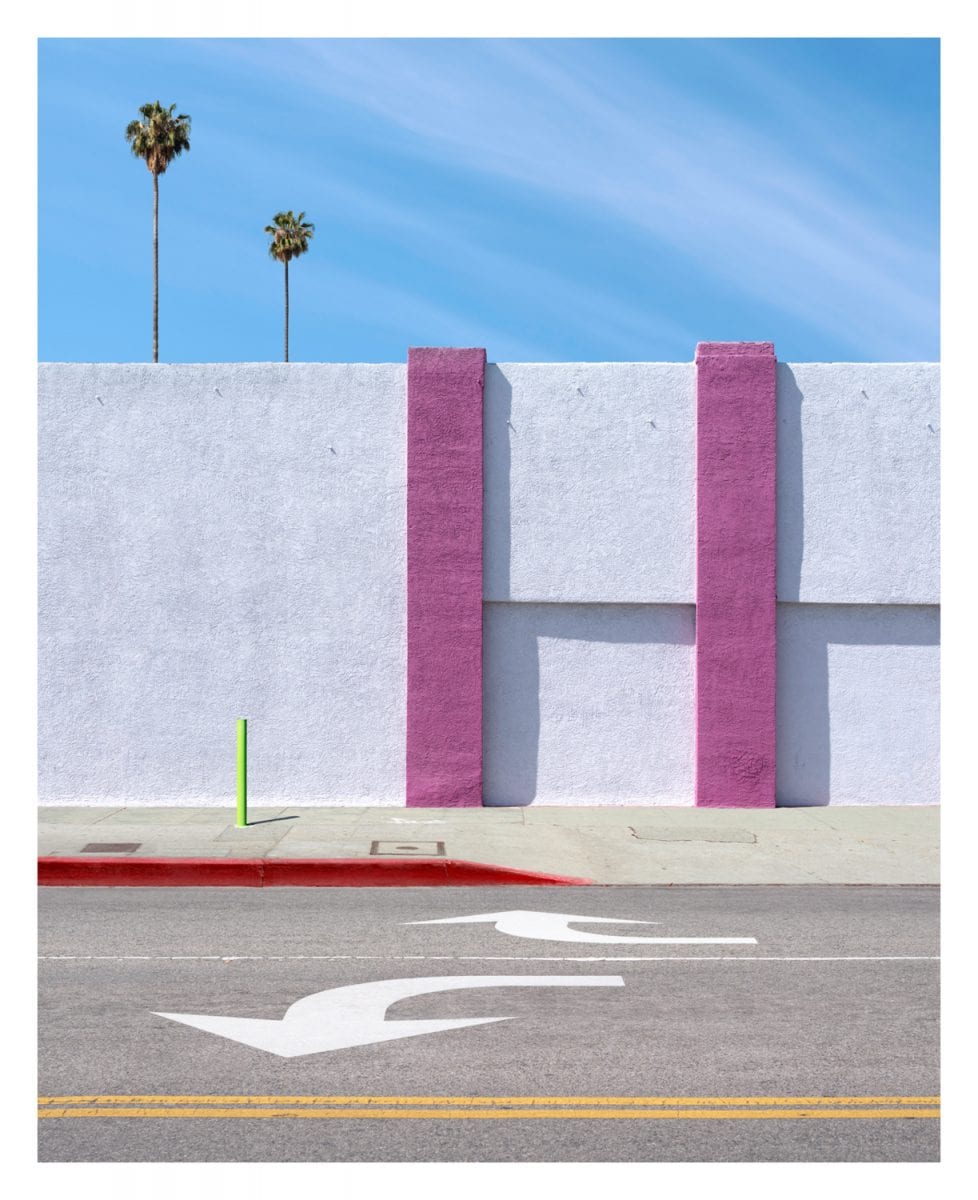
archival pigment print
47.5 x 58.75 in.
Edition of 5 + 2AP
Installation image courtesy of Danny Duarte
Artwork courtesy of George Byrne
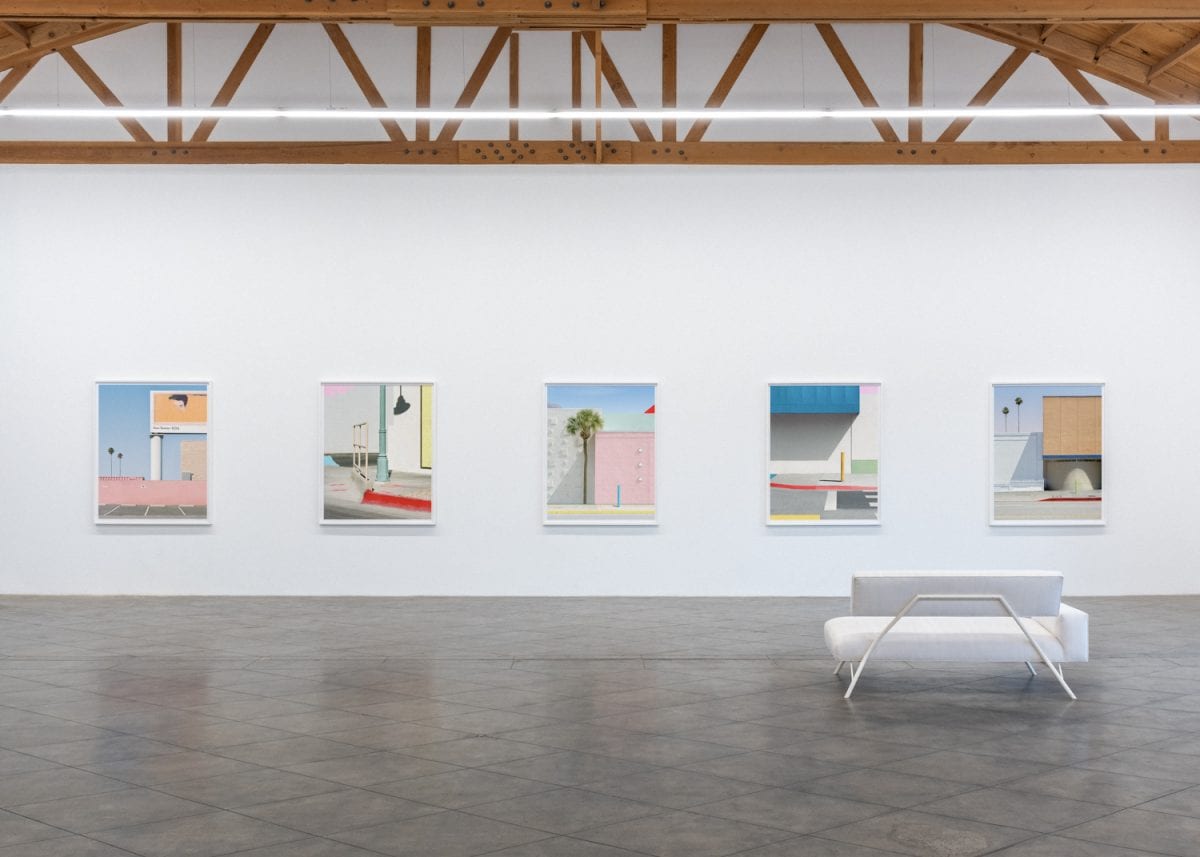
Installation image courtesy of Danny Duarte
Artwork courtesy of George Byrne
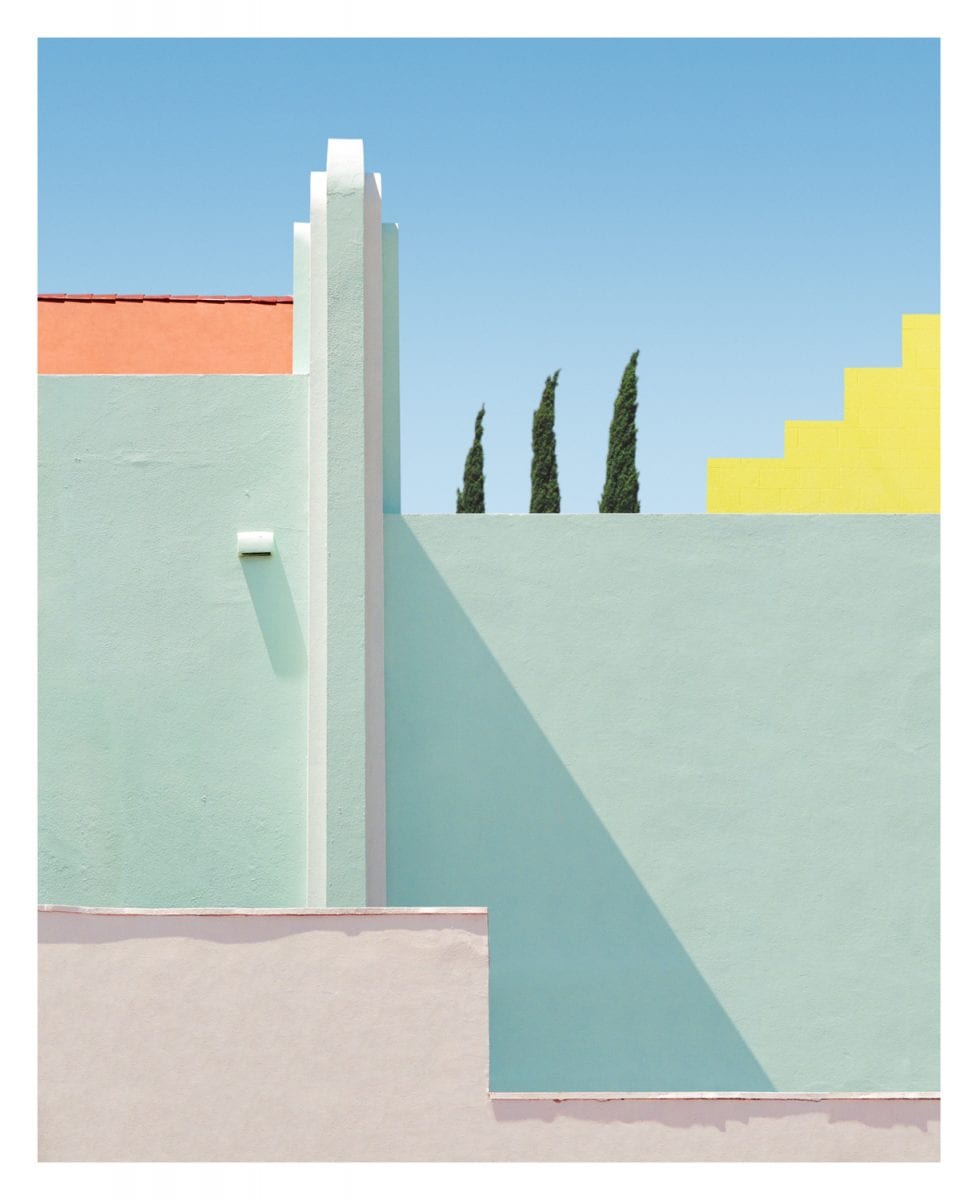
archival pigment print
54.5 x 67.5 in.
Edition of 3 + 2AP
Installation image courtesy of Danny Duarte
Artwork courtesy of George Byrne
Furthermore, it feels like the restraint in your images creates a presence.
Yes and that’s the “it” thing. And maybe that you can never quite describe that. It’s like that feeling at dusk when you have that magic in the air and you go “what is that? I don’t know! It’s just something.” And you can intellectualize all you want but sometimes it’s just a feeling.
I was trying to negotiate the decision behind the title Post Truth. I first considered that it may allude to the initial encounter before any photographs were ever taken. I then feared that I tried to read too far between the lines, the energy inherent to the work would lose its magic.
It certainly wasn’t supposed to be a political statement or a direct comment on exactly what my process was. It was just a really nice term that felt really accurate to the show… I had been grinding for years and then I landed on this show and like a good record, I knew I had ten songs. The image called Post Truth is one of the few images that I remember making and just being so stoked. The bell went off. I never have that. I’m always happy with my work to varying degrees but that one was jumping on top of the table and fist-bumping like I scored a goal. That was a really good creative moment. That was luck again. I’m at my best creatively when I’m fluent with my process and that for me is just flat out repetition. You can’t really cheat that process. I do this for people as well. I am not making my work in a vacuum. Anyone who comes and appreciates what I’m doing- that’s half of why I’m doing it. That’s my engagement with the world. That’s my sense of having some purpose and validation. I never would have thought I would be doing this ten years ago if you asked me but it feels right and when things happen in small increments and they’re lead not by early Hail Marys because of some goal, it feels good. I think the book has brought some reflection that’s been a really good thing for me.
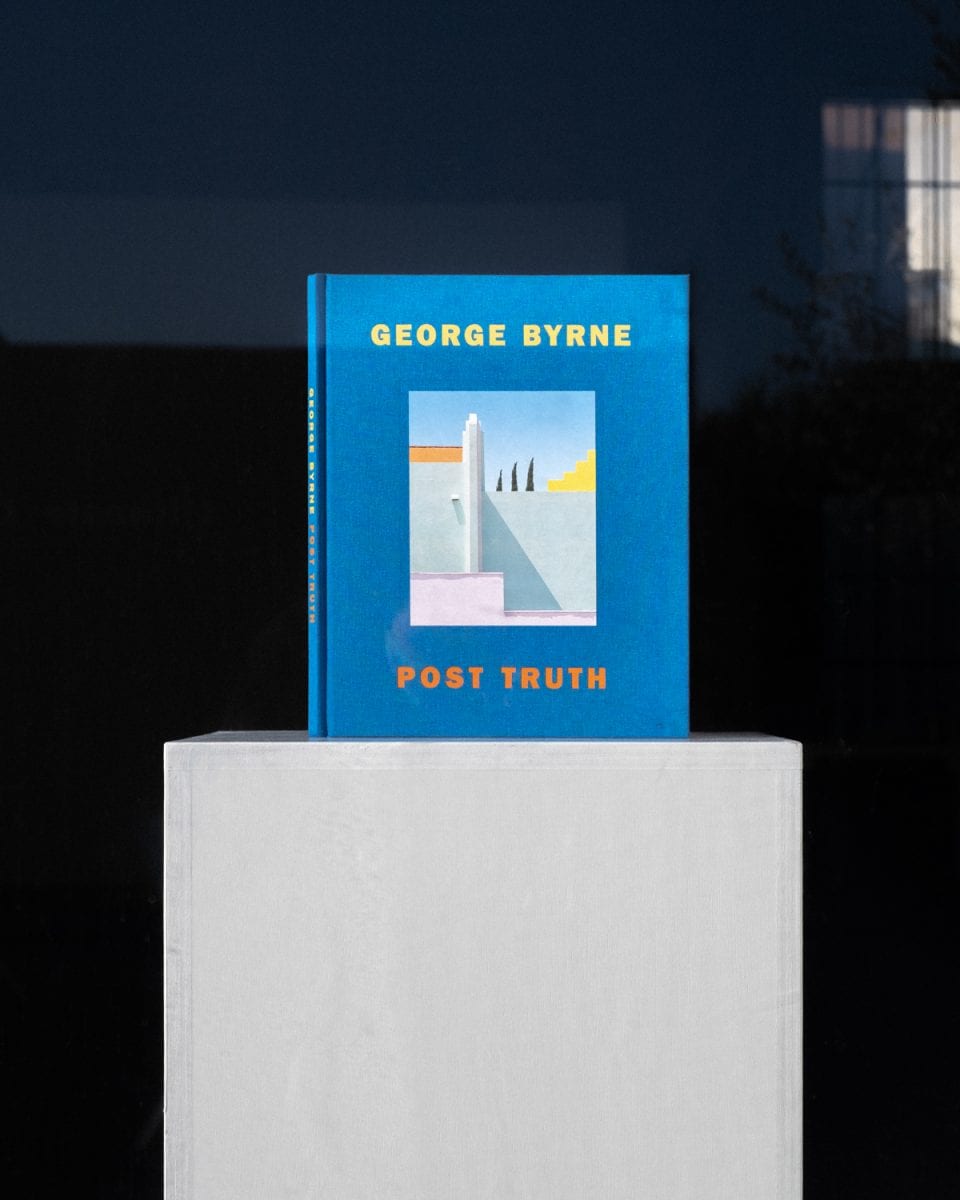
Edition Size: 1500
9.75 x 11.75”
120 Pages, 56 images
Installation image courtesy of Danny Duarte

George Byrne, “Post Truth,” 2018
archival pigment print
54.5 x 67.5 in.
Edition of 3 + 2AP
Installation image courtesy of Danny Duarte
Artwork courtesy of George Byrne
Post Truth exhibition + book launch by George Byrne has been extended through February 28, 2021. The exhibition is on view at domicile (n.) at the Merrick Building in East Hollywood located at 4859 Fountain Avenue Los Angeles, CA. Viewings are scheduled by appointment only.
Purchase Post Truth, by George Byrne
Edition Size: 1500 / 9.75 x 11.75”/ 120 Pages and 56 images/ Released October 29. 2020
The artist has just announced six new limited edition prints measuring 9.75 x 11.75 inches only available online with the purchase of Post Truth. Limited edition of 50 prints are signed and editioned and will be delivered in February 2021.
Featured Image Caption:
George Byrne, “Gas Station, Route 66,” 2018
archival pigment print
58.5 x 47.75 in.
Edition of 5 + 2AP
Installation image courtesy of Danny Duarte
Artwork image courtesy of George Byrne
(Detail View)
Installation Magazine © 2021
